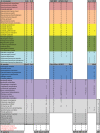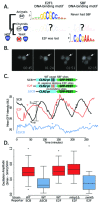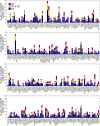Punctuated evolution and transitional hybrid network in an ancestral cell cycle of fungi
- PMID: 27162172
- PMCID: PMC4862756
- DOI: 10.7554/eLife.09492
Punctuated evolution and transitional hybrid network in an ancestral cell cycle of fungi
Abstract
Although cell cycle control is an ancient, conserved, and essential process, some core animal and fungal cell cycle regulators share no more sequence identity than non-homologous proteins. Here, we show that evolution along the fungal lineage was punctuated by the early acquisition and entrainment of the SBF transcription factor through horizontal gene transfer. Cell cycle evolution in the fungal ancestor then proceeded through a hybrid network containing both SBF and its ancestral animal counterpart E2F, which is still maintained in many basal fungi. We hypothesize that a virally-derived SBF may have initially hijacked cell cycle control by activating transcription via the cis-regulatory elements targeted by the ancestral cell cycle regulator E2F, much like extant viral oncogenes. Consistent with this hypothesis, we show that SBF can regulate promoters with E2F binding sites in budding yeast.
Keywords: S. cerevisiae; cell cycle; chytrid; computational biology; evolution; evolutionary biology; fungi; genomics; horizontal gene transfer; systems biology; virus.
Conflict of interest statement
The authors declare that no competing interests exist.
Figures





















References
-
- Adl SM, Simpson AGB, Lane CE, Lukeš J, Bass D, Bowser SS, Brown MW, Burki F, Dunthorn M, Hampl V, Heiss A, Hoppenrath M, Lara E, le Gall L, Lynn DH, McManus H, Mitchell EAD, Mozley-Stanridge SE, Parfrey LW, Pawlowski J, Rueckert S, Shadwick L, Schoch CL, Smirnov A, Spiegel FW. The revised classification of eukaryotes. Journal of Eukaryotic Microbiology. 2012;59:429–514. doi: 10.1111/j.1550-7408.2012.00644.x. - DOI - PMC - PubMed
Publication types
MeSH terms
Substances
Grants and funding
LinkOut - more resources
Full Text Sources
Other Literature Sources
Medical
Molecular Biology Databases

